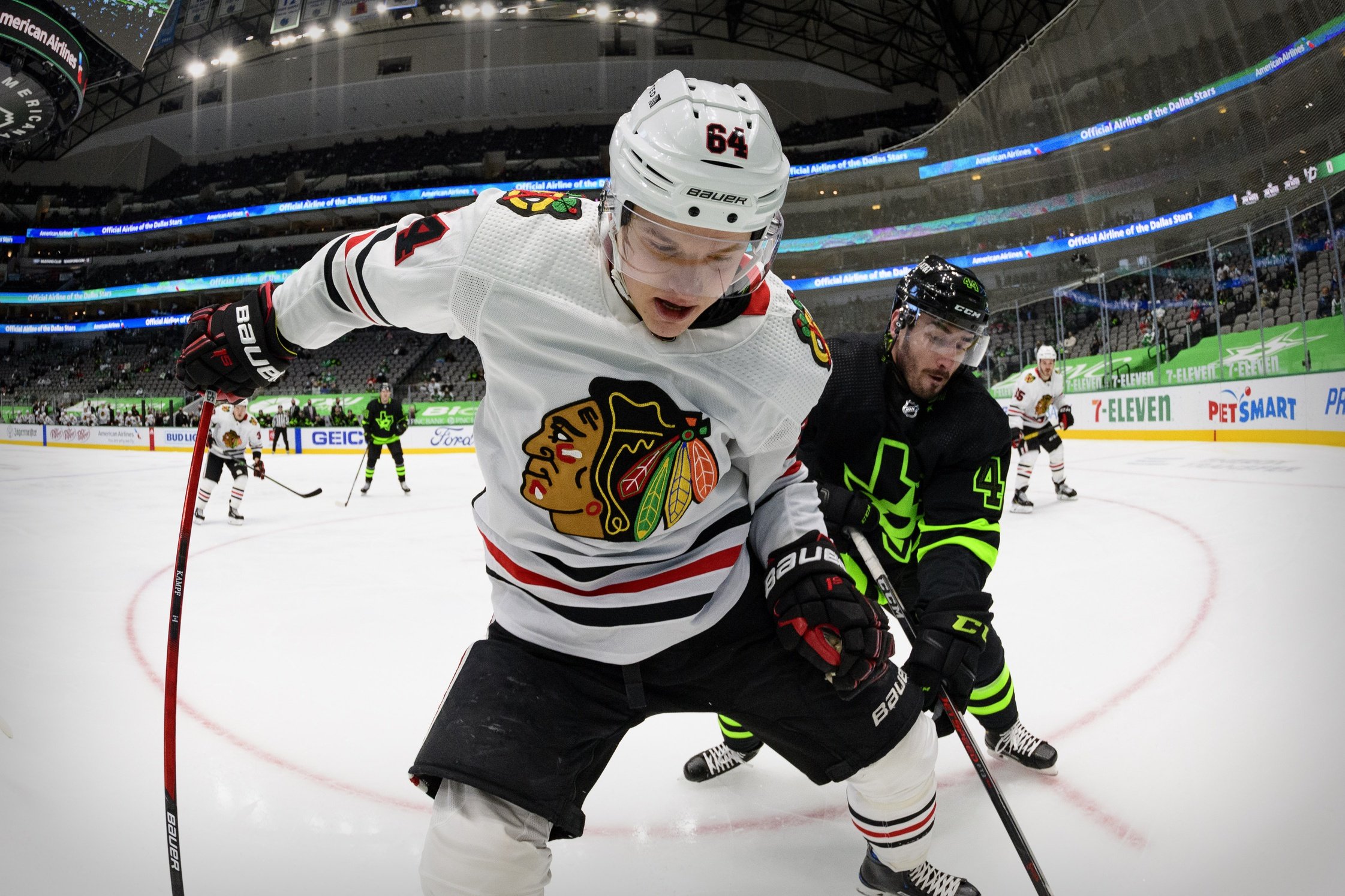As we wait to see what the Toronto Maple Leafs decide to do with their remaining bit of cap space, let’s dive into a few thoughts on their moves so far.
David Kampf and the knock-on benefits of a decent checking line
We know what the Leafs were thinking with the David Kampf addition. It was their exact same logic behind the Riley Nash acquisition before the trade deadline (the timing coming off of the injury at playoff time just didn’t work out with Nash).
The Leafs want a checking center who can take defensive-zone draws and can be spotted in for tough assignments. They have two top-six lines that should be maximized in terms of the scoring situations they’re deployed in — and should have their minutes shaved down a little overall in Matthews and Marner’s case. They also have an effective fourth-line scoring depth center/winger in Spezza who can take the odd defensive-zone draw and get off the ice, but he was still used heavily in offensive-zone situations, and for good reason — he’s committed himself more to this part of the game in his role in Toronto, but he’s not a defensive specialist and never has been.
Kampf and Nash have both succeeded at faceoffs, preventing much from happening while on the ice, and do not get buried in terms of the run of play under a heavy defensive load (This is a good read over at The Athletic on Kampf becoming so reliable in his role under Jeremy Colliton in Chicago). The Leafs have some good checkers on the roster, but Alex Kerfoot, Pierre Engvall, and Ilya Mikheyev cannot take draws well and it’s possible none are best used as full-time centers.
It might seem counterintuitive to add Kampf at $1.5 million AAV (meaning, he is penned in as a regular) when depth scoring seemed to be an issue for the team at playoff time, but ideally, the Leafs can build an additional bottom-six line that plays a similar amount as this checking line with Kampf (who could play with Mikheyev and Engvall, possibly) and can score a little.
What should not be lost in this discussion: The likes of MacKinnon, Rantanen, McDavid, Barzal, Ovechkin, Marchand, Pastrnak, etc. generally start quite a few more of their shifts in the offensive zone than Matthews and Marner did last season. If we look up the offensive zone starts per 60 across the league, it’s littered with elite offensive talents at the top, but Marner and Matthews aren’t high on the list. Sheldon Keefe leaned so heavily on these two all over the ice.
Anthony Petrielli has effectively detailed why the sheer TOI demands on the pair is probably not a sustainably effective approach. An actual checking line of note can be a part of the solution in terms of easing the load a little but still putting them in the right situations to produce massive quantities of offense.
The addition of Petr Mrazek
I rarely have much to say when it comes to analyzing goaltenders. We can dig into the advanced stats on Mrazek’s goals save above expected and high-danger save percentage — he shows well there historically — and pretend we know what the real predictors of success are for goaltenders going from one team to the next. But for 1A/1B goalie types, we all know it comes down to a mix of health, fit, and whatever the psychology/voodoo is that determines if a goaltender plays consistently well or not in any given season.
You can certainly quibble with the AAV or the term and wish it was one year shorter at $3.8m or a half a million less over three years, but when it comes to a position as important as goaltending, it’s just about getting the right one more than these minor considerations. Few goalies play 60+ games anymore, and you need two good ones to finish at or near the top of the division and certainly to go deep in the playoffs.
The bet on Mrazek at $3.8 million is as good as any based on the numbers, his history of handling tandem situations, and the fact that he’ll be playing in comparable enough systems with a defense coach (Dean Chynoweth) that is really familiar with building around Mrazek’s strengths. In addition to performing the character check on what Mrazek is like to partner with for the other goalie in the tandem and running the eye test by the goalie scouts, that’s all you can really bet on.
We know the Leafs liked Mrazek, Ullmark, and Kuemper among those on their shortlist. The Ullmark contract was far too rich, while the price to acquire Kuemper (presumably with some retention) would’ve been extremely pricey in terms of the acquisition cost (Colorado gave up Conor Timmins, a first-round pick, and a conditional third-rounder). This was a sensible enough choice, and now we wait and see how health and performance shake out between him and Campbell.
One point I will make here: Tandem goaltending situations are common across the NHL now, but in Toronto, there is always that extra level of scrutiny that can make life a little more difficult and high-stakes — the decisions around who is starting (especially in the playoffs), whether it should be an equitable the share of the crease to keep both goalies in form or if they simply need to ride the hot hand, and generally how the two goalies are managed throughout the year. There is an appeal to the lack of controversy involved when it’s just a given as to who starts most nights.
It’s the hand the Leafs were dealt this offseason with how it shook out with Campbell and Andersen last season, though, so tandem it is.
Other Quick Notes
– Take a quick peek at the money thrown around at defensemen around the league this week (even mediocre fifth and sixth defensemen!). Let’s just go ahead and call the Holl vs. McCann debate settled.
– The big unknown we are all waiting on is the Leafs’ final addition(s) up front. We know they were in on Brandon Saad, who would’ve been a good fit at $4.5 million AAV, even if the contract length was uncomfortable at five years.
If we’re talking trade options, Reilly Smith ticks a lot of boxes in terms of the fit: versatile (plays either wing), defensively responsible, a legit top-six producer who is a good bet for 20 goals and 50 points, plays a significant role on both special teams, and has lots of playoff success in his recent past. If Vegas is still looking to shed more cap, a retention scenario that brings Smith to Toronto would make a lot of sense on paper. He’s signed for just one more season at $5 million.
Signing Tomas Tatar would take brass balls from Kyle Dubas in terms of his willingness to add a player with such a bad playoff reputation to this Leafs team. But he’s an efficient and consistent regular-season producer at 5v5 and a strong possession player. If he was cheap enough, you could see him slotting in on either top-six line or even on a sheltered scoring line next to Jason Spezza if it didn’t work out higher up the lineup.
Nick Ritchie brings a totally different element and could possibly slot in any of those three spots, too.
– I have a lot more optimism about the bet on Michael Bunting than I did about the strange one made on Jimmy Vesey last offseason. Vesey brings nothing if he isn’t scoring (as in if he’s not being set up and finishing — he can’t create his own offense). Bunting is also an opportunistic scorer, but he plays hungrier and brings an element of going hard to the net / finishing his checks as well.
I hear Anthony’s point about how important it is that one of these bets such as the one on Bunting actually pans out for the Leafs, and how this added importance means it’s not just the typical low-risk flyer. However, Bunting was added for nothing but cash out of the FA pool, he can be buried in the AHL if needed, and he in no way prevents the Leafs from signing additional help or trading for it later (because he won’t be taking up any cap space). For those reasons, it’s still a pretty nice low-risk bet on the upside.
– My instinct on it initially was that the Leafs were going to roll into the year with Travis Dermott, Timothy Liljegren, Alex Biega, and Rasmus Sandin as their four main options for the bottom pairing. Their interest in paying $1.5 million per year for Jani Hakanpaa (per Eric Engels) makes me wonder if they’re still open to investing a little more into a more established #6, or if it was just this particular player they were willing to do it for.


![Jim Montgomery Post Game, Bruins 4 vs. Leafs 2: “[Marchand] still manages to get under people’s skin, yet he doesn’t cross the line” Jim Montgomery, Boston Bruins post game](https://mapleleafshotstove.com/wp-content/uploads/2024/04/jim-monty-pg-to-218x150.jpg)
























![Jim Montgomery Post Game, Bruins 4 vs. Leafs 2: “[Marchand] still manages to get under people’s skin, yet he doesn’t cross the line” Jim Montgomery, Boston Bruins post game](https://mapleleafshotstove.com/wp-content/uploads/2024/04/jim-monty-pg-to-100x70.jpg)







